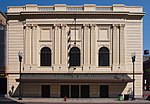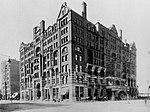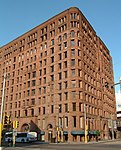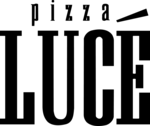Warehouse District/Hennepin Avenue station
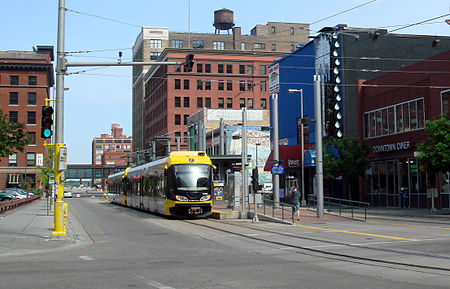
The Warehouse District/Hennepin Avenue station is a light rail station on the METRO Blue Line and Green Line in Minneapolis, Minnesota. This was the original northern terminus of the Blue Line until the new Target Field station opened on November 14, 2009 to provide access to the new Northstar Commuter Rail line. The Warehouse District station is located on 5th Street North, between 1st Avenue North and Hennepin Avenue in downtown Minneapolis. This is a center-platform station with one traffic lane to the south of the platform. Service began at this station when the Blue Line opened on June 26, 2004, and this station is where the opening ceremony was held. The first train departed at 11:00 a.m. on that day. The station was designed by ESG Architecture & Design, who also designed the adjacent Nicollet Mall station. To reflect its neighborhood, the station incorporates brickwork and metal columns into the design. The public art installation, Untilted, by Penny Rakoff and Bill McCullam depict labor disputes that occurred in the city in the first half of the 20th century, most notably the Minneapolis Teamsters Strike of 1934. Images are printed onto ten 15.5 × 12.25 inch and two-hundred 2.75 × 2.75 inch tiles.This station is planned to a stop on the METRO E Line. The Target Center, home of the Minnesota Timberwolves, is a block from the station. Although Target Field station is the official stop for the Minnesota Twins' Target Field, Warehouse/Hennepin also sees significant traffic during Twins games.
Excerpt from the Wikipedia article Warehouse District/Hennepin Avenue station (License: CC BY-SA 3.0, Authors, Images).Warehouse District/Hennepin Avenue station
Hennepin Avenue, Minneapolis
Geographical coordinates (GPS) Address Nearby Places Show on map
Geographical coordinates (GPS)
| Latitude | Longitude |
|---|---|
| N 44.98 ° | E -93.273333333333 ° |
Address
Butler Park
Hennepin Avenue
55403 Minneapolis
Minnesota, United States
Open on Google Maps
